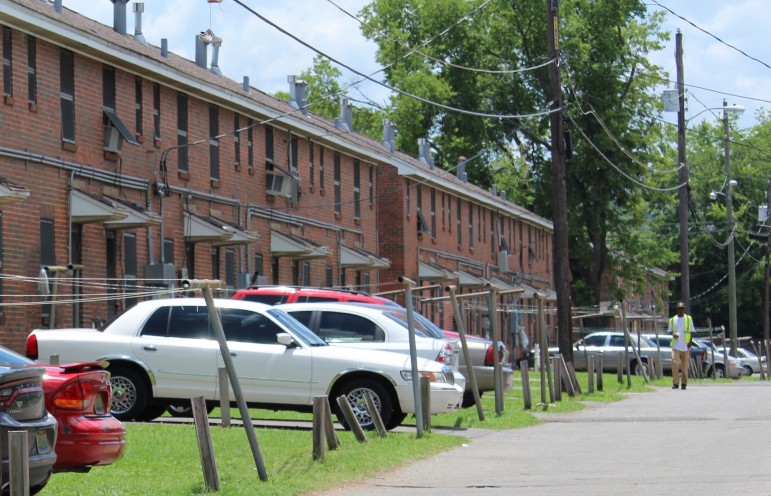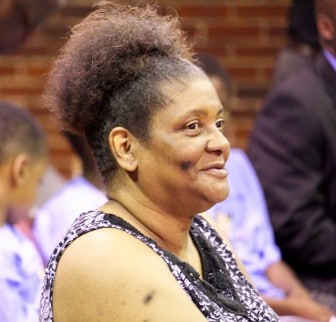A New Direction for Birmingham’s Largest Public Housing Complex
Picture public housing and a certain image comes to mind. Typically, it is one of poverty, where hundreds of people live in a low-income neighborhood. Birmingham’s Housing Authority is hoping to re-shape this picture by re-developing Loveman Village, the city’s largest public housing complex. The idea is to build new apartments and diversify the area, but ultimately, the hope is to change the perception of public housing.
The Plan
Over 100 people fill the gymnasium at Loveman Village. It is standing room only and on this hot summer day, there’s no air conditioning. But the crowd cheers loudly as the Birmingham Housing Authority discusses a plan to redevelop their housing complex.
Located in North Titusville, Loveman Village is so large and so distinct, it feels like a separate neighborhood. The development is home to nearly 500 units and they look about the same as they did when Loveman was first built over 64 years ago. Faded brick buildings line the narrow streets, which are marked by old clotheslines that hang in the front. Director of the Birmingham Housing Authority Michael Lundy says people easily identify the barrack-style apartments as public housing. This is the trend the Authority is hoping to avoid with a nearly $80 million redevelopment plan. “What we’re intending to do is to reduce the size of the developments,” says Lundy, “And create smaller properties and build units that blend into the larger community, that look like traditional market rate housing units.” Old Loveman Village will be demolished, replaced with new, up-to-date apartments. Some will be built where Loveman is now, while others will be relocated to Oxmoor Valley, a higher-income community near the borders of Homewood, Hoover, and Vestavia. Lundy says the goal is to give residents better housing and better opportunity.
The Historic Warehouse Approach
According to the Titusville Community Framework Plan, Loveman Village is currently home to almost 40% of all violent crime in North Titusville. The median household income is listed as less than $9,000, and over half its residents are kids. Lundy says it is a prime example of the impact of concentrated poverty. “We’ve warehoused the poor,” he says, “Everybody at 30% below the area median income, living in you know 3 square miles.” UAB Sociologist and Demographer Dr. Nyesha Black says this ‘warehouse’ approach isolates low-income communities, limiting their access to better education, healthcare, and economic resources. She explains, “The capital that is concentrated in those communities is not enough in the sense to uplift them and get them access to institutions to uplift them out of poverty.”
Beyond Better Housing
Black says new housing is a step forward. It boosts morale and empowers residents. But if we really want to de-concentrate poverty, she says, there has to be a push, by people of all income levels, to diversify; because many neighborhoods are deeply divided by access to wealth, exemplified in places like Loveman. “Anytime where you have had economic and racial segregation, people just don’t have as much exposure to one another,” says Black, “and a lot of that construction of who people are is based off of what you see in the media or social media. It’s hard to bridge those gaps and to facilitate an interchange among people who just don’t come into contact with one another.”
Shifting Perspectives
Esther Muhmoud lives in Loveman Village and is excited about the redevelopment plan. She hopes to relocate to one of the new apartments that will be built in Oxmoor Valley, because she says, for her, living in an economically diverse community makes a difference. “Lower income with some of the higher income, you know, and then it’s just like ‘we equal,’” Muhmoud explains. “All of us are staying here and we equal, and I like that.”
There has been pushback from residents of Oxmoor Valley, fearful of crime and reduced property values. Chris Gonzalez lives in the area and says the resistance is mostly due to the reputation of Loveman Village. “I think if they had just built an apartment complex and said, ‘Hey we’re doing mixed income,’ wouldn’t have been as big an issue as saying Loveman Village is moving there,” says Gonzalez. In response, Esther Muhmoud says people should keep an open mind. “You can’t label everybody the same. I stay in Loveman Village but I’m not what they conceive of being Loveman Village,” Muhmoud states, “but you know it’s good people. It’s good people everywhere, then it’s bad people everywhere.”
A Vision for Change
As the meeting at Loveman comes to a close, residents look forward to the future. Director Michael Lundy says the redevelopment plan is not going to solve every issue, but he hopes it will provide a foundation for long-term change. “Well I think what we have to do as a public housing agency, we have to demonstrate success,” says Lundy. “And success breeds success. And so to the extent that it will begin to change some of the mindset, negative perceptions of public housing.” In the coming years, the Housing Authority will invest millions to rebuild Loveman Village. The idea is, the new structure will no longer confine residents, but rather provide an opportunity for communities to blend together.
Editor’s note: According to the Birmingham Housing Authority, construction at Loveman Village is expected to begin early summer of 2017. Construction of the new development in Oxmoor Valley, located off of Sydney Drive, is expected to begin in the fall of 2016. Currently, as residents of Loveman Village move out of the complex, apartments are boarded up to secure them until they are demolished. The Authority anticipates the redevelopment project will take three years to complete.
How this long-lost Chinese typewriter from the 1940s changed modern computing
The concepts in the MingKwai typewriter underlie how Chinese, Japanese and Korean are typed today. The typewriter, patented in 1946, was found last year in an upstate New York basement.
North Korea has a new luxury beach resort. But the country isn’t open to most tourists
North Korean leader Kim Jong Un said he wants the luxury resort on the eastern seacoast to become a "world destination," but the country has been reluctant to allow in foreign tourists.
Mariska Hargitay walks a fine line in ‘My Mom Jayne’
It's natural to feel some skepticism when a celebrity makes a documentary about their own family. But Law & Order star Mariska Hargitay' tells a story that is both effective and empathetic.
Ukraine says it struck a Russian airbase as Russia sent drones into Ukraine
Ukraine said it struck a Russian airbase on Saturday, while Russia continued to pound Ukraine with hundreds of drones overnight, dashing hopes for a breakthrough in efforts to end the war.
‘Buy now, pay later’ purchases can now affect your credit score. Here’s what that means
Services that split up payments into installments are increasingly popular, especially among young and low-to-middle income shoppers. But now the FICO credit scoring company will be tracking that debt.
Will Trump’s megabill help Democrats win the House?
Democrats feel that Trump's tax and spending bill gives them an opening ahead of the 2026 midterms. But if they want to win back the House, they're going to have to get their own house in order first.












